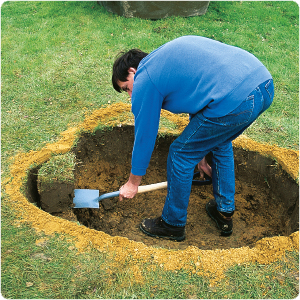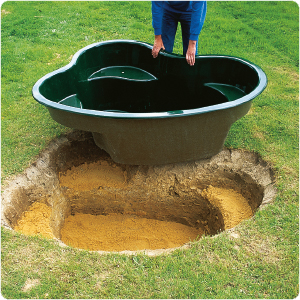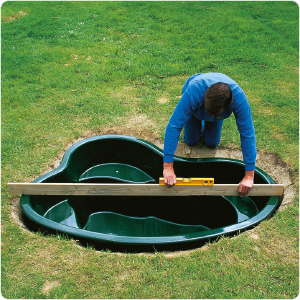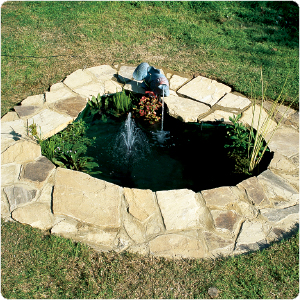Building a preformed pond
Preformed ponds offer a quick and effortless way to introduce water into the garden. The shape is already designed to offer an attractive and practical home for pond fish and marginal planting baskets.
How to build a preformed pond
1. Marking out and digging

Place the preformed pond on the ground where it will be installed. Mark around the shape of the pond with sand and remove the pond.
Dig out the shape of the pond, using the sand line as a marker.
Allow an extra 5cm depth for a layer of sand to be added.
Measure the depth of the shelf, then dig to this level.
2. Remove debris

Once the shape and shelves have been dug out, remove any stones that may pierce the pond.
Place the pond in the hole, ensuring it is at the correct level relative to the surrounding area.
If necessary, dig out any excess areas. Line the base of the pond and the shelves with sand and
place the pond back into the hole.
3. Check the pond is level

Using a spirit level, ensure the pond is level. Once level, use the spoil from the hole to back fill the pond. Ensure the soil is compacted down, to prevent the pond from shifting as it is filled with water.
Once filled, leave the pond for at least one week before adding edging stones, waterfalls and plants etc.
This will ensure that any ground movement does not result in having to re-install pond décor.
4. Finishing touches

Before adding edging materials, ensure you allow space for electrical connections.
When installing electrical items around the pond, use a switchbox designed for water garden use. Once the pond has been filled with water, it can be treated with a dechlorinator to remove harmful chemicals.
Plants can be added and should be left for a period of 2 weeks to establish before the first few fish are introduced.
How to make your preformed pond look natural
There are a few ways you can give your preformed pond a more natural look, making it a centrepiece of your garden. Here are some effective additions to your pond:
Natural edging
Instead of leaving the edge of the pond bare or sharp, use natural materials to create a soft transition from land to water. Rocks, pebbles, and boulders can be placed around the pond’s perimeter to mimic the look of a natural water body.
Introduce plants
Plants play a key role in creating a natural environment in your pond. Choose a variety of submerged, floating, and marginal plants to add depth and interest. Some great options include:
- Water lilies: These provide cover for fish and help to reduce algae growth.
- Hornwort and anacharis: Submerged plants that oxygenate the water and provide shelter.
- Bulrush and reedmace: Marginal plants that thrive in shallow water and add height and texture.
Add a fountain or waterfall
Adding a fountain or waterfall pump to your pond can boost its aesthetic appeal and create a soothing atmosphere. The sound of bubbling water not only attracts wildlife but also provides a calming backdrop for your outdoor space.
How to choose the right location for your preformed pond
Choosing the right spot for your pond is key to keeping your fish healthy and the water clean. Here are some things to consider when picking the perfect location:
- Sunlight: Ideally, your pond should get around 4–6 hours of sunlight each day. This is great for plant growth and helps keep the water healthy. Too much sun, though, can encourage algae, while too little can affect both plants and fish.
- Shade: If your garden gets a lot of sun, try placing the pond in a spot with partial shade. This helps keep things balanced, reducing algae growth while still providing enough light for plants and fish.
- Nearby Trees: While trees offer shade, their roots can disrupt the pond’s structure, and fallen leaves can make a mess. Try to place your pond away from large trees, or use a leaf net to keep the water clean.
- Accessibility: Pick a spot that’s easy to reach for maintenance. You’ll want to be able to clean the pond, add plants, and handle any electrical connections for things like fountains or lights without much hassle.
